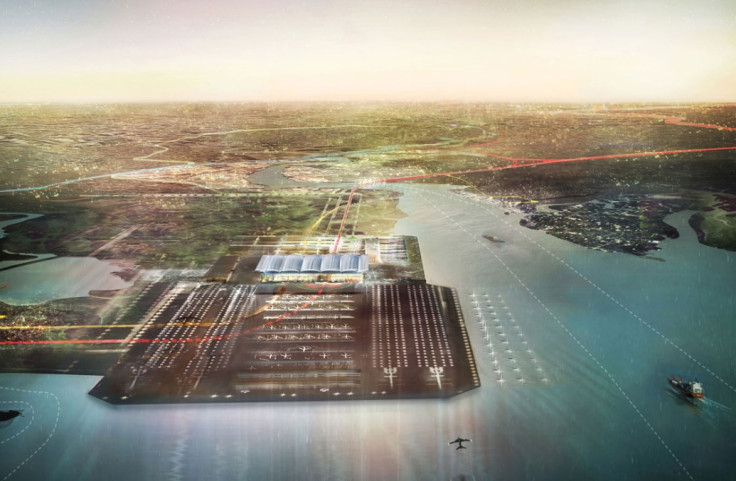Boris Johnson was right about 'Boris Island' – expanding Heathrow is a mistake
350 years since the Great Fire of London, our leaders are still choosing the cheapest option.

As Chris Grayling rose to tell the House of Commons on Tuesday that the government was approving a third runway at Heathrow, I was on a half-term day out at the Museum of London's Great Fire exhibition with my six-year-old daughter.
We peered at 17th century maps showing the cramped layout of the city's streets, homes so close together that people could lean out of their upstairs windows to shake hands with their neighbours on the other side of the road.
As is well-known, this haphazard, cheek-by-jowl arrangement of buildings and roads allowed the 1666 fire to easily spread. In the aftermath, as the exhibition reminded us, there was a great opportunity to rebuild London for the coming Enlightenment era.
Sir Christopher Wren, who had recently studied the architecture of Paris, proposed a complete redesign, with open boulevards and well-ordered garden squares. But the devastation caused by the fire meant money, already constrained, had to be spent on urgent remedial work.
The priority was finding the cheapest solution in the quickest time. It was deemed to be no moment for grand, horizon-scanning projects. London was rebuilt to roughly the same layout, albeit with wider streets. The capital has kept its quaint, unique design, but it remains cramped, and planning is a nightmare.
Now, 350 years on from the Great Fire, the same mistakes are about to be made. When he delivered his Commons statement on airport capacity, the Transport Secretary claimed that Heathrow offered the greatest access for business, by road and rail, and was the best equipped to expand as a worldwide hub.
Boris Island was an airport for the next century, not merely a decade from now.
Backing Grayling, George Osborne, who as Chancellor ensured that Heathrow expansion was back on the table during the last parliament, warned on Twitter against "another false start" adding, with a sense of urgency: "let's set to it".
Supporters of Heathrow expansion like to convey this urgency, arguing that for Britain to remain competitive with China in the next decade the strip of tarmac to the north west of Heathrow must be built as soon as possible.
It is true that the challenge of airport capacity, particularly post-Brexit, is one to be addressed urgently. Yet in this haste, the squeezing of another runway into a densely populated, densely polluted part of west London is blind short-termism. It meets the demands of the next decade, but when more capacity is needed, then what? A fourth runway, and then a fifth?
Instead, the government, business and airlines must think not of 10 years in the future but 100. What is the best solution for London, and Britain, for the 22nd century? What would a 21st century Wren propose, if he were able to submit evidence to the Davies Commission or present plans to Theresa May?

As bizarre as it seemed when the then Mayor of London proposed it, Boris Johnson's plan for an entirely new airport to the east of London, a runway archipelago on the Thames Estuary, is surely what Wren would have proposed if he were around today.
Boris Island was an airport for the next century, not merely a decade from now. Johnson's plan was dismissed as harebrained, an impossible vanity project that could never be built. No matter that several major world cities have built new hub airports outside the capital.
As with the rebuilding of London after 1666, those in authority are grasping for the cheapest solution in the quickest time.
The Foreign Secretary may have flip-flopped on Brexit but on infrastructure he has the clear, long-sighted vision of Wren, not only on airports but on railways, proposing a network of super-fast Maglev trains across the country that would cut journey times far more dramatically than HS2.
I am not the Foreign Secretary's greatest defender, but on Boris Island he was right. The plan was dismissed early on by the Davies Commission, not least because of the time and cost – close to £50 billion – it would take to build a new hub from scratch.
By contrast, a new runway at Heathrow will be relatively cheaper, at £17.6billion – although there are extra costs of around £5billion for road and rail improvements. Grayling told the Commons that Heathrow expansion would bring "even greater prosperity for future generations".
But, as with the rebuilding of London after 1666, those in authority are grasping for the cheapest solution in the quickest time. And now, as then, they are wrong.
Jane Merrick is a freelance journalist and former political editor of The Independent on Sunday. She writes an allotment blog, www.heroutdoors.uk.
© Copyright IBTimes 2025. All rights reserved.






















